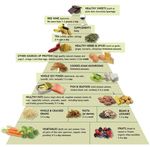AN INTEGRATIVE APPROACH TO THE MENOPAUSE TRANSITION
←
→
Page content transcription
If your browser does not render page correctly, please read the page content below
1 AN INTEGRATIVE APPROACH TO THE MENOPAUSE TRANSITION Priscilla Abercrombie, RN, NP, PhD, AHN-BC HS Clinical Professor Obstetrics, Gynecology & Reproductive Sciences UCSF Community Health Systems, School of Nursing UCSF Chronic Pelvic Pain Clinic UCSF Osher Center for Integrative Medicine SFGH Women’s Health Center Founder, Women’s Health & Healing
Integrative Medicine • The practice of medicine that reaffirms the importance of the relationship between practitioner and patient, focuses on the whole person, is informed by evidence, and makes use of all appropriate therapeutic approaches, healthcare professionals and disciplines to achieve optimal health and healing.” Consortium of Academic Health Centers for Integrative Medicine
3 Menopause • 12 months of no menstrual period, it is a retrospective diagnosis • Average age of menopause 51.4 • Menopause is the result of the natural decline in the hormones produced in the ovaries. • Symptoms vary greatly from woman to woman.
Other Types of Menopause • Surgical menopause: both ovaries are surgically removed. • Medical menopause: induced by certain drugs or treatments such as chemotherapy or radiation therapy. • Premature ovarian failure (primary ovarian insufficiency): is the loss of ovarian function before the age of 40 years.
5 Common Conditions After Menopause Osteoporosis • Incidence substantially increased after menopause • Estrogen reduction increases bone resorption Atherosclerotic disease • Rates in women increase after age 50 • The leading cause of death in both women and men
8 Physical Activity • Weight-bearing exercise for bone strength: walking, dancing, and jump rope • 30 minutes of aerobic exercise at least 5 days per week: reduces heart disease, cancer, obesity (CDC) and depression (Dunn, 2005). May reduce hot flashes. • Flexibility training, such as yoga, to decrease falls 2- 3x/week • Strength training to improve muscle mass 2-3x/week
Developmental Transition • Time of exploration: • Meaning of midlife and aging • Role and purpose in life • Changes in relationships with children, partner and parents occur • Experience of menopause influenced by: • Sociocultural background • Women with a negative attitude toward menopause have more symptoms
Spiritual Life • Participate in activities that bring purpose and meaning to life • Take time for reflection • Journaling • Consider writing an ethical will. (See Women’s Legacies website) • Walks in nature • Religious activities: prayer, meditation, and ritual
SYMPTOM MANAGEMENT
12
Menopausal symptoms
Vasomotor Genitourinary Other Systemic
Headache Vaginal dryness Fatigue
Palpitations Dyspareunia Reduced sexual
desire or arousal
Night sweats Vaginal itching or Anxiety, irritability,
Insomnia/ burning depression
sleep
disturbance
Urinary frequency, Cognitive difficulties
ARHP dysuria, urgency Backache, stiffness13 Hot flashes • Prevalence from 35–50% in perimenopause to 30– 80% in postmenopause (NIH, 2005). • Usually end 1-2 years after menstruation has ceased but can continue for 5 years or more. • Symptoms range from flushing or warmth in the face and upper body to sweating and chills lasting an average of 4 min., 20% women find them intolerable. • Can lead to severe sleep disturbances. • Appear to be the result of mixed signals from the hypothalamus, resulting in altered thermoregulation, the exact mechanism is unknown
Hormone Therapy: Women’s Health Initiative - First randomized,
controlled trial in women (50-79 years) treated with HRT
6700 women with 5.2 years of follow-up
Difference % vs. placebo
Vertebral fracture
Intestinal cancer
Disadvantages
160
Hip fracture
120 +112%
80
+29% +41%
40 +26%
0
Tromb. venous
Breast cancer
Stroke
diseases
Cardiovascular
-40
-37% -34% -34%
-80
Advantages
Manson JE at al, N Engl J Med, 2003;349:523-534
14Hormone Therapy Risk
HT risk is related to:
• A woman’s baseline disease risks
• Her age
• Age at menopause
• Cause of menopause
• Time since menopause
• Prior use of any hormone
• HT types, routes of administration,
and doses used
• Emerging medical conditions
during treatment
NAMS position statement. Menopause 2012.Risks and Benefits of HT • Benefit: most effective treatment for vasomotor symptoms • recommended for moderate to severe hot flashes • Contraindications: history of breast cancer, heart disease, blood clots, hypertension, stroke, and undiagnosed vaginal bleeding • Risks: ischemic stroke, blood clots, and breast cancer
“Bioidentical” does not mean “natural”
• Bioidentical refers to structure
• They have the same biochemical structure as endogenous
hormones
• Natural refers to the source of hormones
• Phytoestrogens come from plants (Ex. soy) but they are not
biochemically similar to endogenous hormones
• Is premarin natural because it comes from pregnant horse urine?
See Sood et al. (2011) JABFMCompounded HT is not synonymous with BHT
• Bioidentical hormones can be obtained from
compounding pharmacists or FDA pharmaceuticals
• Compounded drugs are prepared by a pharmacist according to
prescriber specifications
• Formulations may include, lotions, creams, gels, suppositories etc.
• FDA approved and custom compounded hormones both contain
USP grade hormones
• Either the compounding pharmacy or the pharmaceutical company
prepare them for useFDA approved products offer some advantages • FDA approval means that the product has undergone testing, scrutiny, and standardization • Custom compounded hormones are regulated by state boards of pharmacy, not the same federal laws • There is less systematic reporting and tracking of side effects • With compounding there is a higher probability of dosing variations • Compounding pharmacies use different delivery vehicles which may effect absorption • Look for accreditation by the Pharmacy Compounding Accreditation Board • Insurance is more likely to cover FDA approved drugs
No hormone is thought to be absolutely safe • Compounded hormones are often times promoted as safer • Many proclaim that estriol is protective against breast cancer • Not enough research to support this • It is thought whether a bioidentical hormone is compounded or not does not influence its safety- same biological activity
Hormone therapy includes bioidentical hormones and synthetic
• Not all prescription hormones are synthetic
• There are both bioidentical hormones and synthetic
available in conventional FDA approved products
• These are available in many different formulations: pills,
patches, creams, lotions, vaginal suppositories, rings, or
creams etc.
• Some are combinations of estrogen and progestinsBenefits of individualization of dosing and
hormone testing have not been established
• Each woman is unique and has varying proportions of
endogenous hormones
• Use standardized hormone levels in these tests
• Bioidentical hormones do not necessarily recreate the internal
milieu
• Estrogen and progesterone levels are low at menopause
• No advantage to testing to look at baseline
• Serum or saliva levels may not be clinically relevant
• Testing may be more helpful when not getting clinical response
• Salivary tests may not reflect serum levels, may be better for
certain delivery systems
• Transdermal estrogenEstriol is a weak estrogen but not necessarily benign • Relatively common for compounded HT to include estriol • Safety claims based on some rodent studies • Thought to block estrogen receptors in the breast and protect against breast cancer • Used in Europe and Japan for urogenital atrophy and recurrent urinary tract infections
Not all progestogens are a like • Bioidentical progestogen is progesterone • Prometrium (micronized progesterone) is the only product available • Synthetic progestogens are progestins • Examples: northindrone, medroxyprogesterone acetate • They both help protect the lining of the uterus from cancer • They have different effects outside of the uterus • Progesterone (not well studied) • Less effect on lipids • Improves sleep, mood and has some diuretic effect • Transdermal may not protect endometrium • Compounded useful with peanut allergy • Less risk for breast cancer?
Use of DHEA and testosterone is controversial
• DHEA
• Available as dietary supplement and compounded
• Precursor to testosterone and estrogen
• Not good research to support its use
• May help with hot flashes and bone density
• Some evidence for its use as a vaginal suppository for atrophy and
improved sexual function (Panjari, 2011)
• Testosterone
• Most common in the setting of removal of the ovaries
• In combination with estrogen in postmenopause can have a
positive effect on sexual desire (NAMS)
• Compounded best option for treatment, no FDA approved products
for womenHT Discontinuance & Symptom
Recurrence
• 50% chance of symptoms recurring when HT
discontinued
• Vasomotor symptom recurrence similar whether
tapered or abrupt discontinuance
• Data conflicting regarding breast cancer
incidence after discontinuance
• Decision to resume HT must be individualized
NAMS position statement. Menopause 2012. Copyright 200827 Non-Hormonal Drugs • Randomized controlled trials show evidence for the efficacy for the treatment of vasomotor symptoms (Cheema, Coomarasamy, & Toukhy, 2007; Nelson et al., 2006). • Anti-depressants (SSRI, SSNRI) • Clonidine • Gabapentin • Less effective than HT but good alternative for women who are not candidates for HT. • Studied in women with breast cancer and were found to be safe for use.
28 Lifestyle and behavioral changes • Identify hot flash • Exercise regularly triggers • Use relaxation • Modify environment: techniques: hypnosis, keep temperature MBSR and paced cool, wear cool breathing clothes, drink chilled • Lose weight beverages • Stop smoking • Seek social support • Learn sleep hygiene and opportunities to strategies share experiences
Herbs and Supplements • Magnesium oxide 400-800 mg daily • Black cohosh insufficient evidence to support it’s use (Cochrane, 2012) • St John’s Wort (alone or with other herbs) • Shown to treat mild to moderate depression well (Linde, 2005) • 300- 600 mg three times a day • Many drug interactions including estrogen • Siberian rhubarb (Estrovera) (Kaszkin-Bettag, 2009) • Sage dried 500-1000mg twice a day (Bommer, 2011) • Soy: add 1-2 servings of whole food sources to your diet
Alternative Therapies
• A review of acupuncture
treatment for menopausal
symptoms found it to be
associated with a
reduction in the number of
hot flashes (Borud &
White, 2010).
• Homeopathy studies show
improvement in symptoms
and quality of life (Jacobs,
2005; Clover, 2002)
30Urogenital Atrophy • Decreasing estrogen levels: less vaginal lubrication and vaginal elasticity and thickness (Speroff & Fritz, 2005). • 50% of women experience problematic vaginal dryness • 40% of the sexually active women have dysparuenia (Huang et al., 2010).
Treatment
• Low-dose vaginal tablets, rings, and creams are equally
effective.
• Less systemic and endometrial effects with estradiol or
estriol
• Does not generally require a progestogen for the
prevention of endometrial hyperplasia (NAMS, 2010).
• Not adequately studied in women with breast cancer (Al-
Baghdadi & Ewies, 2009).
• May be of some benefit for women with urge incontinence
(NAMS, 2010)
• May reduce the risk of recurrent urinary tract infection
(Perrotta, Aznar, Mejia, Albert, Ng, 2008)
• Estriol is a weaker estrogen well absorbed from vaginal
mucosa (must be compounded)Other Treatments • Vaginal moisturizers • Lubricants for sexual intercourse: jojoba oil, silicone based, water based • Maintain sexual activity: women who are sexually active have less vaginal atrophy • There is mounting evidence that DHEA suppositories improve vaginal atrophy, sexual pain and sexual desire.
Mood Symptoms • 11–21% of perimenopausal women and 8–38% of postmenopausal women. • Limited evidence that changes in ovarian function are the cause of depression, anxiety, or irritability during the menopause transition (NIH Consensus Statement, 2012). • Women who experience vasomotor symptoms and insomnia are more at risk for depression (Gyllstrom, Schreiner, & Harlow, 2007). • Women with a history of depression or PMS are more vulnerable to relapse during perimenopause. (NAMS)
Cognitive Symptoms • Difficulty thinking, forgetfulness, and other cognitive disturbances are frequently reported during the menopause transition. • Existing studies have not been able to separate the effects of aging from the effects of menopause (NIH Consensus Statement, 2005). • There are decreasesin attention/working memory, verbal learning and verbal memory, and fine motor speed in the first year after menopause (Weber, 2013).
Treatment of Cognitive Symptoms • In a large longitudinal study, hormone therapy (HT) with conjugated equine estrogen did not prevent dementia or cognitive decline in women older than age 65 years (Coker et al., 2009). • HT was associated with adverse effects on cognition persisting years after therapy in this group of women. • More research is needed to understand whether estrogen may be beneficial when initiated after surgical menopause or earlier in midlife.
Herbal Adaptogens • Rhodiola rosea: depression, insomnia and chronic fatigue, anxiety • Start with 100- 150 mg per day x 1-2 weeks then 340-400 mg daily • Ashwagandha (withania somnifera): enhance physical and mental health, increase resistance to disease • Available as OTC supplement Gaia etc. • Bacopa monnieri: memory, cognition and enhance learning, relieves anxiety • 200-400 mg per day in 2-3 divided doses
Sexual Functioning • Decline in sexual function is related to a decline in estradiol levels, not androgen levels (Dinnerstein, 2003 ). • In one Australian study, during perimenopause scores indicating sexual dysfunction rose from 42% to 88%. • Sexual function in midlife women is complex. • Not only affected by hormonal changes but by: • premorbid sexual functioning, personality, educational level, stress, physical and psychologic health status, partner health status, and the woman’s feelings toward her partner. • The level of distress experienced as a result of the sexual problems should be assessed.
Decreased Desire • Treat contributing psychologic (depression, relationship issues, boredom, etc.) or underlying medical conditions • Change or discontinue medication contributing to decreased desire • The use of testosterone in women with disorders of sexual desire is controversial. • The addition of an androgen to estrogen therapy demonstrated a significant positive incremental effect on sexual functioning in women (Cochrane Review, 2005 )
Candidates for Testosterone Therapy
Postmenopausal women may be candidates for
testosterone therapy if they:
• present with symptoms of decreased sexual desire
associated with personal distress and
• have no other identifiable cause for their sexual concerns
Do not initiate testosterone therapy in postmenopausal
women with:
• breast or uterine cancer
• cardiovascular disease
• liver disease
NAMS position statement. Menopause 2005. Copyright 2005Botanicals • Traditionally prescribed: American ginseng (Panax quinquefolius), damiana (Turnera aphrodisiaca), and wild oats milky seed (Avena sativa). • Although there is a long history of traditional use of herbs for decreased sexual desire, there is little research evidence to support their use.
Increasing sexual pleasure • Over-the-counter products include L-arginine (oral), Zestra cream • Enhance stimulation and eliminate routine: use erotic materials, masturbation, encourage communication during sex, use vibrators, varying positions, vary times of day or places, and make a date for sex • Provide distraction techniques: erotic or non-erotic fantasy, Kegel exercises with sex, background music, or videos or television • Encourage non-coital behaviors: sensual massage, sensate-focus exercises, oral or non-coital stimulation with or without orgasm
43 Summary • Providing integrative health care for women during the menopause transition involves incorporating many different avenues of healing. • There are a number of CAM treatments that can be safely integrated into care although their effectiveness has not been adequately studied in many cases. • Integrative practitioners are ideally suited to provide care for the women during the menopause transition; addressing her mind, body and spirit.
You can also read



























































